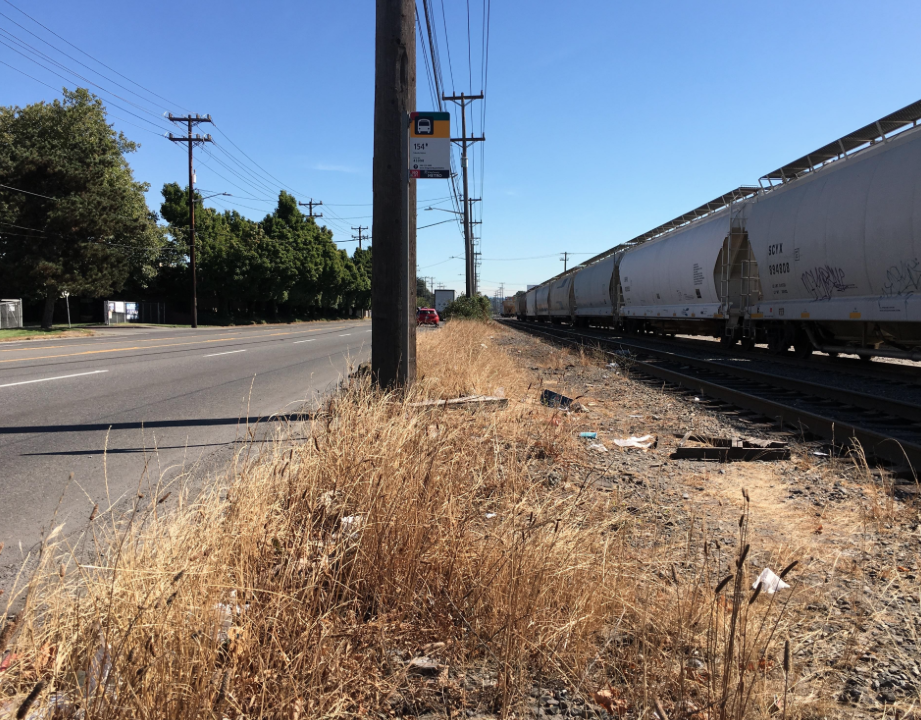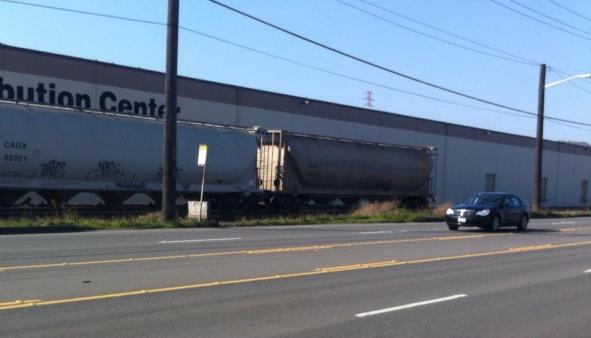America, here is your sorriest bus stop.
Streetsblog readers have anointed this bus stop in Seattle -- where riders have to wait on a narrow patch of grass between a high-speed road and an active freight rail track -- as the worst of 2017's field of 16 sorry bus stops.
In a competitive championship match, a late surge of reader votes carried the Seattle stop to victory over a similar bus stop in Munhall, Pennsylvania.
A spokesman for King County Metro, Scott Gutierrez, left this comment during the final match:
Metro recognizes our bus stop won’t win any beauty contests. It’s in an industrial area and currently has no ridership, with nearby stops that have almost no ridership, and we are currently looking at whether this stop should be removed.
For some background: This stop serves four afternoon trips on a single route and currently logs zero riders per day. The sheltered stop across the street, which has a sidewalk, averages 2 riders per weekday. The next stop to the north at East Marginal Way and Fourth Avenue South -- a signalized intersection with sidewalks -- averages 2 ons/0 offs per weekdays. The bus stop to the south at Corson Avenue South and East Marginal Way -- also a signalized intersection with sidewalks -- averages 1 on/0 off per weekday. The stops are about 900 feet apart, which is consistent with our guidelines under most conditions.
Metro has more than 8,000 bus stops and works with city transportation departments and others to invest in shelters and passenger facilities where ridership and demand most warrant them. We have a strong commitment to improving access to transit, and we prioritize resources where improvements would benefit far greater numbers of Metro riders.
This raises the question: How would usage change if the bus stops on this route were better? Is ridership so low because few people want to make bus trips, or because few people feel comfortable getting to and from the bus on this street? Would more people ride to the community college served by this bus stop if the waiting area was safer and more comfortable?
In Metro's defense, the transit agency doesn't control this street -- Seattle DOT does. As is often the case with sorry bus stops, it's up to the DOT to provide good pedestrian access to the waiting area. But here it doesn't look like Seattle DOT has given any thought at all to people outside cars.
A few years ago, at least someone was thinking of the people who use this bus stop. One of our readers shared this photo from 2013 of a makeshift bench made for the bus stop using wooden pallets:
As much as we enjoy the competition, the point of the Sorriest Bus Stop tournament is not to crown a champion, but to draw attention to the poor conditions too many bus riders deal with due to neglect by multiple layers of government. Bus stops matter: In a TransitCenter survey [PDF], bus riders ranked comfortable waiting environments as the fourth most important aspect of their experience, following speed, frequency of service, and the price of a fare.
The 2017 bracket generated the most local media coverage we've seen in the three years since we started pitting sorry bus stops against each other. The Pittsburgh Post-Gazette, the Seattle Post Intelligencer, the East Bay Times, the Seattle Times, and several local TV stations all produced coverage of waiting environments in need of attention.
Coverage like that has led to improvements for bus stops in prior competitions. Last year's runner-up, a Kansas City bus stop by the Royals' Kaufmann Field, received a well-publicized "makeover." In Rochester, another 2016 top finisher, volunteers are building seats to make waiting for the bus more comfortable.
There are tens of thousands of sorry bus stops around the nation, and we can't fit every one in the tournament, but we hope this exercise gets more DOTs and transit agencies to treat poor walkability and uncomfortable waiting areas as serious problems that deserve their attention.
Correction: This post originally stated that Washington DOT has jurisdiction over the street with this year's sorriest bus stop. The post has been corrected to reflect that it is under Seattle DOT's purview.







